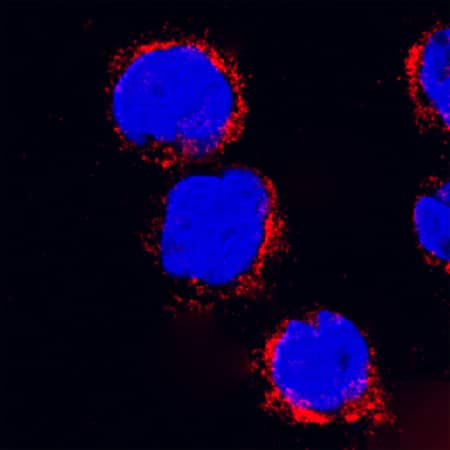Human LAMP-1/CD107a Antibody
R&D Systems, part of Bio-Techne | Catalog # MAB4800


Key Product Details
Validated by
Species Reactivity
Validated:
Cited:
Applications
Validated:
Cited:
Label
Antibody Source
Product Specifications
Immunogen
Ala28-Asn380
Accession # P11279
Specificity
Clonality
Host
Isotype
Scientific Data Images for Human LAMP-1/CD107a Antibody
LAMP1/CD107a in Human Kidney.
LAMP1/CD107a was detected in immersion fixed paraffin-embedded sections of human kidney using Mouse Anti-Human LAMP1/CD107a Monoclonal Antibody (Catalog # MAB4800) at 15 µg/mL overnight at 4 °C. Before incubation with the primary antibody, tissue was subjected to heat-induced epitope retrieval using Antigen Retrieval Reagent-Basic (Catalog # CTS013). Tissue was stained using the Anti-Mouse HRP-DAB Cell & Tissue Staining Kit (brown; Catalog # CTS002) and counterstained with hematoxylin (blue). Specific staining was localized to lysosomes in epithelial cells. View our protocol for Chromogenic IHC Staining of Paraffin-embedded Tissue Sections.LAMP‑1/CD107a in THP‑1 Human Cell Line.
LAMP-1/CD107a was detected in immersion fixed THP-1 human acute monocytic leukemia cell line using Mouse Anti-Human LAMP-1/CD107a Monoclonal Antibody (Catalog # MAB4800) at 25 µg/mL for 3 hours at room temperature. Cells were stained using the NorthernLights™ 557-conjugated Anti-Mouse IgG Secondary Antibody (red; Catalog # NL007) and counterstained with DAPI(blue). Specific staining was localized to cytoplasmic. View our protocol for Fluorescent ICC Staining of Cells on Coverslips.Detection of Human LAMP-1/CD107a by Western Blot
Increased SNX9 expression and co-localization with podocin are detectable in the cytoplasm of ADR-treated WT podocytes, whereas SNX9 KD podocytes exhibit little cytoplasmic expression of podocin.(a) Fluorescent micrographs of cultured human podocytes stained with SNX9 (green) and podocin (red) before and after ADR treatment (merged areas are in yellow). DAPI (blue) was used to indicate nuclei. Boxes indicate higher magnification areas presented in the lower panels. (b) Western blot analyses of the fractions from control podocytes or podocytes treated with ADR separated on linear OptiPrep gradients (5–25%). Distributions of SNX9 and podocin, as well as marker proteins of plasma membrane (caveolin), endosome/lysosome (LAMP1), mitochondria ( beta subunit of F1F0-ATPase), and endoplasmic reticulum (calnexin), were examined by western blot analysis. (c) Cultured human podocytes were transfected with nonfunctional control siRNA (upper panel) or SNX9 siRNA (middle and lower panels). Transfected cells, as decided by GFP expression, are indicated by arrowheads. Upper panel: Fluorescent micrographs of control siRNA-transfected podocyte stained with SNX9 (red). Middle panel: Fluorescent micrographs of SNX9 siRNA-transfected podocyte with ADR treatment stained with SNX9 (red). Lower panel: Fluorescent micrographs of SNX9 siRNA-transfected podocyte with ADR treatment stained with podocin (red). DAPI (blue) was used to indicate nuclei. Boxes indicate higher-magnification areas presented on the right. Image collected and cropped by CiteAb from the following publication (https://pubmed.ncbi.nlm.nih.gov/28266622), licensed under a CC-BY license. Not internally tested by R&D Systems.Applications for Human LAMP-1/CD107a Antibody
CyTOF-ready
Immunocytochemistry
Sample: Immersion fixed THP-1 human acute monocytic leukemia cell line
Immunohistochemistry
Sample: Immersion fixed paraffin-embedded sections of human kidney
Intracellular Staining by Flow Cytometry
Sample: THP‑1 human acute monocytic leukemia cell line fixed with paraformaldehyde and permeabilized with saponin
Reviewed Applications
Read 1 review rated 5 using MAB4800 in the following applications:
Formulation, Preparation, and Storage
Purification
Reconstitution
Formulation
Shipping
Stability & Storage
- 12 months from date of receipt, -20 to -70 °C as supplied.
- 1 month, 2 to 8 °C under sterile conditions after reconstitution.
- 6 months, -20 to -70 °C under sterile conditions after reconstitution.
Background: LAMP-1/CD107a
Lysosome-associated membrane protein-1 (LAMP1), also known as CD107a, is a 100‑130 kDa member of the LAMP family of glycoproteins. It is expressed in lysosomal and plasma membranes of macrophages, NK and T-cells, and with LAMP2, is essential for the formation of phagolysosomes. On the cell surface, it also presents carbohydrates to selectins. Mature human LAMP1 is a 389 amino acid (aa) type I transmembrane glycoprotein. It contains a 354 aa luminal/extracellular domain (ECD) (aa 28‑381) and a 12 aa cytoplasmic tail (aa 405‑416). The ECD has two large looping regions (aa 28‑193 and 227‑381) plus multiple N- and O-linked glycosylation sites. There is one potential splice variant that shows a 26 aa substitution in the signal sequence. Over aa 28‑380, human LAMP1 shares 64% aa identity with mouse LAMP1.
Long Name
Alternate Names
Gene Symbol
UniProt
Additional LAMP-1/CD107a Products
Product Documents for Human LAMP-1/CD107a Antibody
Product Specific Notices for Human LAMP-1/CD107a Antibody
For research use only

